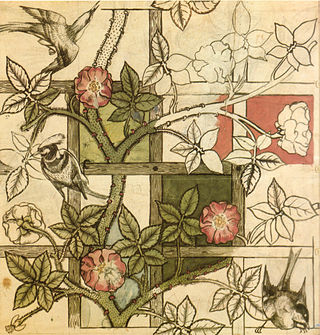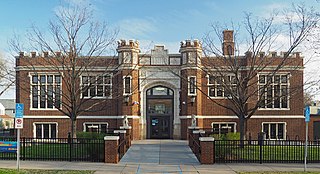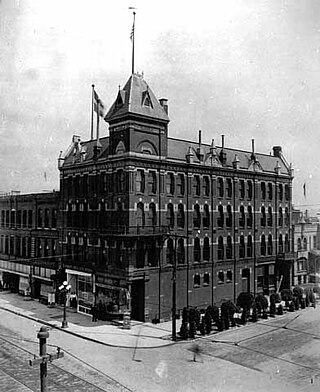
The Arts and Crafts movement was an international trend in the decorative and fine arts that developed earliest and most fully in the British Isles and subsequently spread across the British Empire and to the rest of Europe and America.

The Walker Art Center is a multidisciplinary contemporary art center in the Lowry Hill neighborhood of Minneapolis, Minnesota, United States. The Walker is one of the most-visited modern and contemporary art museums in the United States and, together with the adjacent Minneapolis Sculpture Garden and the Cowles Conservatory, it has an annual attendance of around 700,000 visitors. The museum's permanent collection includes over 13,000 modern and contemporary art pieces including books, costumes, drawings, media works, paintings, photography, prints, and sculpture.
The Minneapolis College of Art and Design (MCAD) is a private college specializing in the visual arts and located in Minneapolis, Minnesota. MCAD currently enrolls approximately 800 students. MCAD is one of just a few major art schools to offer a major in comic art.

Charles Robert Ashbee was an English architect and designer who was a prime mover of the Arts and Crafts movement, which took its craft ethic from the works of John Ruskin and its co-operative structure from the socialism of William Morris.

Marcy-Holmes is a defined neighborhood in the U.S. city of Minneapolis. The majority of the area is residential and sits upon a bluff overlooking the river and the city skyline. However, a small section of the neighborhood along the river is an industrial zone.
Minneapolis is the largest city in the US state of Minnesota, and the county seat of Hennepin County.

The University of Minnesota Old Campus Historic District is a historic district located in Minneapolis, Minnesota. Listed in the National Register of Historic Places since 1984, it includes a number of historic buildings that were constructed during the late 1800s and early 1900s. The district represents the oldest extant section of the University of Minnesota campus.

Frederick G. Kees was an American architect notable for his work in Minnesota and partnerships with Franklin B. Long and Serenus Colburn.
The Handicraft Guild was an organization central to Arts and Crafts movement active in Minneapolis, Minnesota, United States, from 1904 to 1918. The Handicraft guild was founded, led, and staffed primarily by women, making it historically significant to women's art movements nationwide.

William Ellery Channing Whitney was an American architect who practiced in Minneapolis, Minnesota. He specialized primarily in domestic architecture, designing homes for many prominent Twin Cities families.
Minnesota Center for Book Arts (MCBA) is the largest and most comprehensive independent nonprofit book arts center in the United States. Located in Minneapolis, Minnesota, MCBA is a nationally recognized leader in the celebration and preservation of traditional crafts, including hand papermaking, letterpress printing and hand bookbinding, as well as the use of these traditional techniques by contemporary artists in creating new artists' books and artwork.

The Edwin H. Hewitt House is a historic house in the Stevens Square neighborhood of Minneapolis. Edwin Hawley Hewitt (1874–1939) was a prominent local architect. He designed this house, at the corner of Franklin Avenue and Stevens Avenue, in 1906. It was listed on the National Register of Historic Places in 1978.

Hosmer Library, originally known as the Thirty-Sixth Street Branch Library, is a branch library of the Hennepin County Library system serving the Central neighborhood of Minneapolis, Minnesota, United States. It was named the Hosmer Library in honor of James Kendall Hosmer and was listed on the National Register of Historic Places in 2000.

Edwin Hawley Hewitt was an American architect from Minnesota. In 1906, he designed the Edwin H. Hewitt House in the Stevens Square neighborhood of Minneapolis, listed on the National Register of Historic Places in 1978.

Dania Hall was a cultural center and performing arts space in the Cedar-Riverside neighborhood of Minneapolis. Completed in 1886, the building was destroyed by an accidental fire in 2000 at the outset of an extensive renovation project.

Mary Moulton Cheney was an artist and visual arts educator in Minneapolis. In addition to her own work with printmaking, bookbinding and design, she was also involved with the Minneapolis College of Art and Design, the Handicraft Guild and other arts organizations in the city.
(Mary) Emma Roberts (1859–1948) was a US American artist and visual arts educator who worked primarily in Minneapolis, Minnesota. She produced watercolor paintings of plants and flowers, was one of the cofounders of the city's Handicraft Guild and also worked as an arts educator in the Minneapolis Public Schools.
Liebenberg and Kaplan (L&K) was a Minneapolis architectural firm founded in 1923 by Jacob J. Liebenberg and Seeman I. Kaplan. Over a fifty-year period, L&K became one of the Twin Cities' most successful architectural firms, best known for designing/redesigning movie theaters. The firm also designed hospitals, places of worship, commercial and institutional buildings, country clubs, prestigious homes, radio and television stations, hotels, and apartment buildings. After designing Temple Israel and the Granada Theater in Minneapolis, the firm began specializing in acoustics and theater design and went on to plan the construction and/or renovation of more than 200 movie houses throughout Minnesota, North and South Dakota, Iowa, and Wisconsin. Architectural records, original drawings, and plans for some 2,500 Liebenberg and Kaplan projects are available for public use at the Northwest Architectural Archives.

The Palace Theatre is a historic theater in Saint Paul, Minnesota. Dating from 1916, it was renovated in 2016 to become a live music venue.

Winchell Trail is a five-mile (8 km) round trip, pedestrian-only trail in Minneapolis, Minnesota, United States, that runs along the west side of the Mississippi River between Franklin Avenue South and East 44th Street. Popular with bird watchers and naturalists, the rustic trail provides Upper Mississippi River gorge access and views. The trail is separate from the adjacent multi-use bicycle path, taking hikers past sandy beaches, an oak savanna restoration project, and the floodplain forest. The trail has multiple access points and the section from East 38th Street to East 44th Street is paved. Described as moderate and for all hiking skill levels, the out-and-back Winchell Trail has total elevation gain of 501 feet (153 m). Portions of the trail can be hiked in near solitude as its age and general destitute make it a widely forgotten place to explore.
















